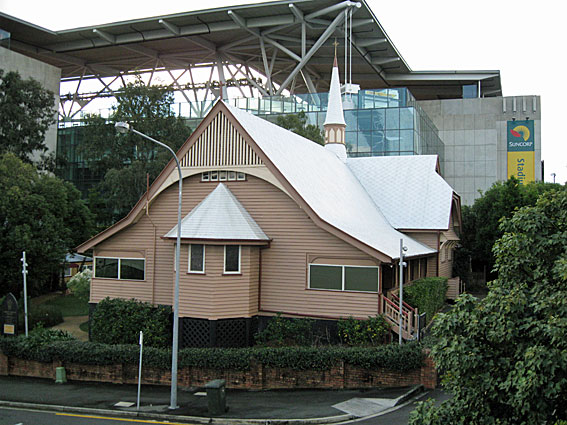
Christ Church Anglican Church, Milton,
now dwarfed by Suncorp Stadium
[Photograph by Geoffrey Cox (July 2011)]

Christ Church Anglican Church, Milton,
now dwarfed by Suncorp Stadium
[Photograph by Geoffrey Cox (July 2011)]
Historical and Technical Documentation by Geoffrey Cox
© OHTA 2011, 2017 (last updated January 2017)
The Parish of Milton became independent of All Saints', Wickham Terrace, in 1873.1 Prior to this, Anglicans in the area had met for worship in the mortuary chapel of the cemetery. Land was purchased adjacent to the cemetery and a new stone church was opened and dedicated in January 1876, built to the design of Richard Suter, the Diocesan architect.
After storm damage in 1890 and problems with the foundations, the stone church was replaced by the present timber building in 1891, which was originally intended as a temporary church and Sunday school. Opened and dedicated on 18 September 1891, it was designed by J.H. Buckeridge, the Brisbane Diocesan architect of the time.2 Other churches by Buckeridge in a similar style include St John the Baptist Anglican Church, Bulimba (1888) and St Thomas' Anglican Church, North Ipswich (1889). The church has been dwarfed by modern development, but has survived as part of a tiny historic precinct immediately adjacent to Suncorp Stadium.
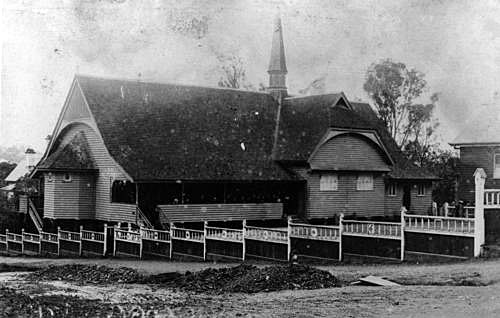
Christ Church, Milton, c.1912
[Photograph: John Oxley Library, State Library of Queensland]
The organ appears to have been completed in May 1922 by Whitehouse Bros of Brisbane at a cost of £895.3 It was one of their standard pneumatic-action instruments of the period, proudly described at the time as follows:
NEW ORGAN FOR CHRIST CHURCH.
It is some time since a new pipe organ has been installed in Queensland, and for this reason the instrument to be erected in Christ Church, Milton, is of considerable interest on that account. The organ has been built by the well known firm of Whitehouse Bros., Brisbane. . . . [The specification follows, as given below] . . . The action is tubular pneumatic throughout, and the pipes are on 3in. wind pressure.
The sound boards are built upon the latest improved system, and there is a separate pallet for each pipe. Queensland timber has been used almost entirely in the construction, and the organ has been built specially to suit the climate. The front pipes of the organ will be silvered. The case is of polished Queensland silky oak, and the organ is to be blown by the electric rotary blower.4

[Photograph by Geoffrey Cox (July 2011)]
The organ originally comprised eight speaking stops, with space for a further four to be added, two on the Swell and two on the Great:
| GREAT Open Diapason Dulciana [Stop Diapason] [Principal] Flute SWELL Open Diapason Lieblich Gedact Salicional [Gemshorn] [Cornopean] Oboe PEDAL Bourdon COUPLERS Swell to Great Swell to Pedals Great to Pedals Swell Super Octave Swell Sub Octave |
8 8 [8] [4] 4 8 8 8 [4] [8] 8 16 |
[std bass] [prepared for] [prepared for] [gvd bass] [gvd bass] [prepared for] [prepared for] [Operating through to Great Organ] [Operating through to Great Organ] |
Tremulant
Tubular-pneumatic action
Attached drawstop console
Hitchdown-lever swell pedal
Radiating concave pedalboard
2 thumb pistons to Great Organ
2 thumb pistons to Swell Organ
Compass: 58/30.5
On Saturday 17 June 1922, shortly after the organ was opened, a recital was given by Mr George Sampson, the organist of St John's Cathedral, Brisbane.6
This instrument was almost identical with the one built by Whitehouse Brothers shortly afterwards in the same year for the Presbyterian Church, Fortitude Valley.7 With eight speaking stops, the specifications of the two were the same and the arrangement of the façade pipes was very similar, the only difference being that the side-flats (each of three pipes) were positioned slightly lower at Milton, presumably to fit within the arch. Whereas the console at Fortitude Valley was originally detached and placed in front of the pulpit, the Milton console has always been attached. The case and organ bench are of silky oak.8
The Milton instrument was restored in 1964 by Whitehouse Bros, and dedicated "in sincere appreciation of Emma Jackson, church organist from 1918-1964". The plaque on the console states that the organ was "rebuilt" in 1964, but the original pneumatic action was retained, and Mr Kevin M. Whitehouse confirmed that the organ was simply "restored" at this time.9
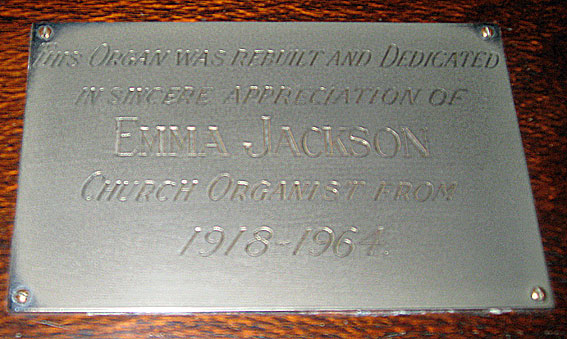
The plaque for Emma Jackson (1964)
[Photograph by Geoffrey Cox (July 2011)]
In 1984, during the time of David Leaver as organist, the action was electrified by H.W. Jarrott of Brisbane, with the assistance of Ray Smith and volunteers from the congregation.10 The changes at this time included the provision of new keyboards and console fittings, painting of the Pedal Bourdon 16ft pipes, additional couplers and thumb pistons, the replacement of the original lever-swell by a balanced swell pedal, extension of the Pedal Bourdon to provide a Bass Flute 8ft; and (apparently) the transposition of the original Swell Open Diapason 8ft to become a Principal 4ft.
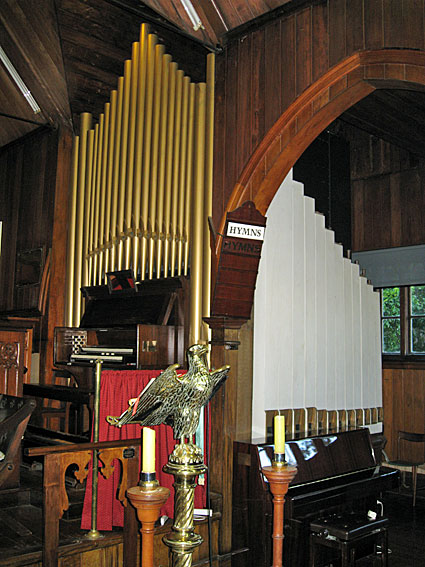
The organ viewed from the nave,
showing the Pedal Bourdon pipes, painted in 1984
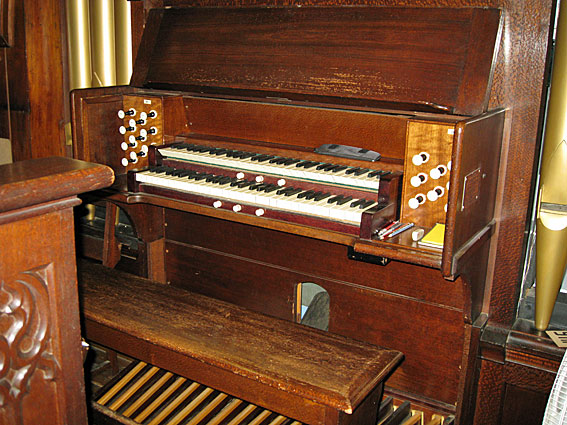
New keyboard and console fittings (1984)
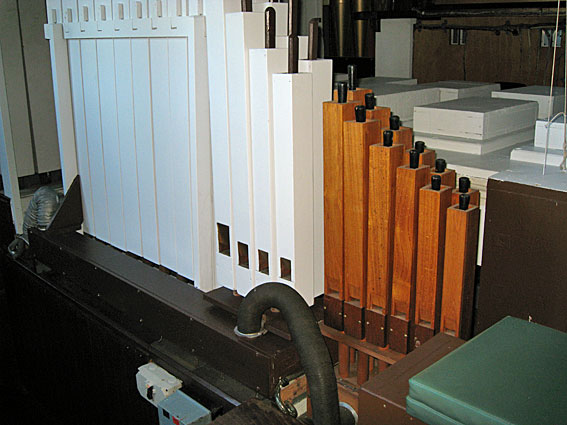
Twelve pipes added to the Pedal Bourdon (1984)
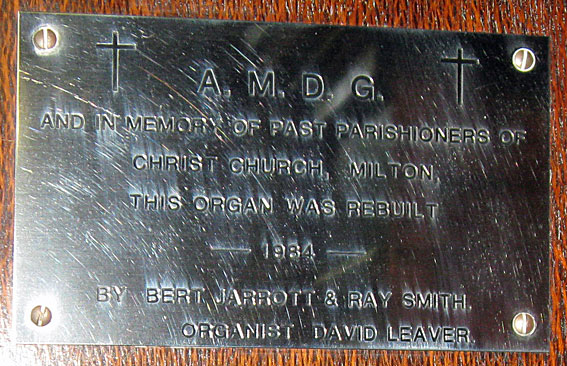
Plaque noting the rebuilding of the organ in 1984
[Photographs by Geoffrey Cox (July 2011)]
The specification of the organ following the 1984 enlargement was as follows:
| GREAT Open Diapason Dulciana Flute SWELL Gedackt Salicional Principal Oboe PEDAL Bourdon Flute COUPLERS Swell to Great Swell to Pedal Great to Pedal Swell Super Octave Swell Sub Octave Swell Super to Great Swell Sub to Great Great Super |
8 8 4 8 8 4 8 16 8 |
[std bass] [gvd bass] A A |
Tremulant
Direct electric action
Attached drawstop console
Balanced swell pedal
Radiating concave pedalboard
3 thumb pistons to Great Organ
3 thumb pistons to Swell Organ
Compass: 58/30.11

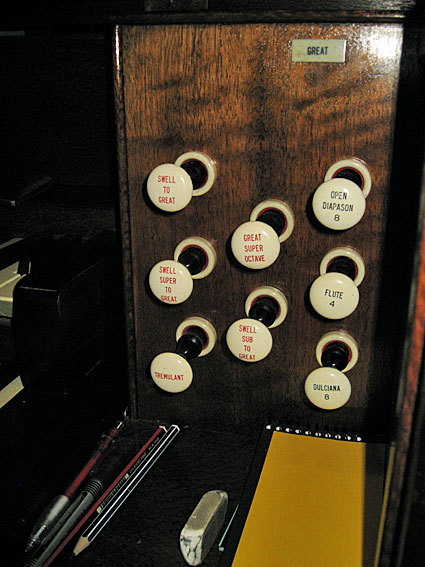
Stop jambs following the rebuilding of the organ in 1984
[Photographs by Geoffrey Cox (July 2011)]
The bellows were recovered in 2004 by W.J. Simon Pierce of Brisbane, following destruction by rodents.12 Tuning slides were added in 2010 by W.J. Simon Pierce to the Great Open Diapason 8ft and Dulciana 8ft.13
The church and organ were water-damaged in a freak storm that devastated several locations in Brisbane on 27 November 2014. The roof at Christ Church was found to contain asbestos, which had contaminated parts of the organ. After being placed in storage at St Alban's, Auchenflower, the instrument was sold to Simon Pierce in December 2016 and broken up.14
_______________________________________________________________________
1 E.J.T. Barton (ed.), Jubilee History of Queensland: a Record of Political, Industrial, and Social Development, from the Landing of the First Explorers to the Close of 1909 (Brisbane: H.J. Diddams, [c.1910]), p. 136.
2 Queensland Heritage Council, Queensland Heritage Register, location 600252; Donald Watson & Judith McKay, Queensland Architects of the 19th Century: A Biographical Dictionary (Brisbane: Queensland Museum, 1994), pp. 25-26.
3 The Whitehouse summary list gives the date as 1921 (presumably the signing of the contract), and the cost as £895. Whitehouse Bros Ledger (1922-1940), p. 120 records only the third and fourth installments, totaling £455, and gives the date as 1922.
4 The Queenslander (20 May 1922), p. 40
5 The Queenslander (20 May 1922), p. 40; Specification noted by G. Cox, May 1974 & September 2010; Additional details from Collected Organ Specifications of Bernie Brohan (c.1952).
6 The Brisbane Courier (16 June 1922), p. 4.
7 The Fortitude Valley instrument is now located at the Uniting Church, Beaudesert.
8 Record of Church Furnishings (2008) by the Australian Decorative and Fine Arts Society (ADFAS) Brisbane Rivers Inc., cited by Graham Hyde (organist), 2011.
9 Personal communication to G. Cox from Kevin Whitehouse, c.1974.
10 Personal communication to G. Cox from Graham Hyde (organist), 2010, and plaque on the console, cited September 2010.
11 Specification noted by G. Cox, September 2010.
12 The Organ Voice, vol. 31, no. 4 (December 2004), p. 14.
13 Personal communication to G. Cox from Graham Hyde (organist), 2010.
14 Personal communication to G. Cox from Simon Pierce, January 2017.